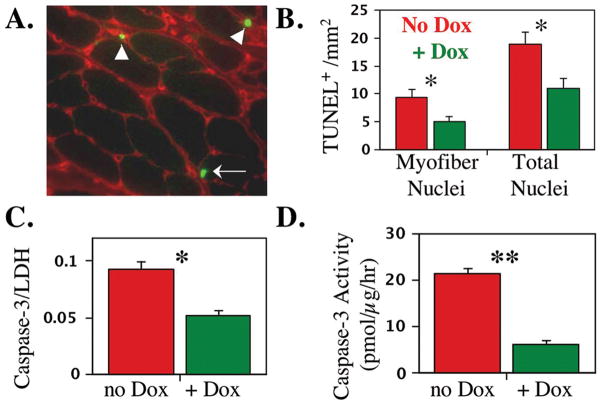Fig. 8.
Doxycycline-treated Lama2-/- muscles had fewer TUNEL-positive nuclei and less activated caspase-3 than untreated Lama2-/- muscles, which is consistent with decreased apoptosis in the treated muscles. A. Representative section of a Lama2-/- soleus muscle assayed for TUNEL-positive nuclei (green) and pan-laminin isoforms (red). The arrow indicates an example of a TUNEL-positive myofiber nucleus located within the laminin sheath is indicated and the arrowheads indicate two examples of interstitial TUNEL-positive nuclei. B. Quantitative analysis of myofiber and total (myofiber + interstitial) TUNEL-positive nuclei in Lama2-/- soleus muscles showed that doxycycline-treated muscles (green bars) had significantly fewer myofiber and total TUNEL-positive nuclei than untreated muscles. C. Quantitative immunoblots showed that doxycycline-treated Lama2-/- diaphragm muscles had significantly less of the 17kDa activated form of caspase-3 than untreated muscles. Equal amounts of protein (50 μg) were analyzed for each sample, and equal loading was verified by immunoblotting for lactate dehydrogenase (LDH, not shown). The 17kDa caspase-3/LDH ratio is plotted. D. Caspase-3 enzyme activity assays similarly showed that doxycycline-treated Lama2-/- diaphragm muscles had significantly less caspase-3 activity than untreated muscles expressed as pmol product produced/μg tissue extract/hour. Errors bars = SE; **P<0.01. * P<0.05.

